India has witnessed significant employment growth over the years. With the employment increased by nearly 36%, adding around 17 million jobs during 2016-17 and 2022-23, India’s economic trajectory demonstrates sustained job creation across key sectors. With a robust democracy, dynamic economy, and a culture that celebrates unity in diversity, India’s journey toward becoming a global powerhouse continues to inspire the world!
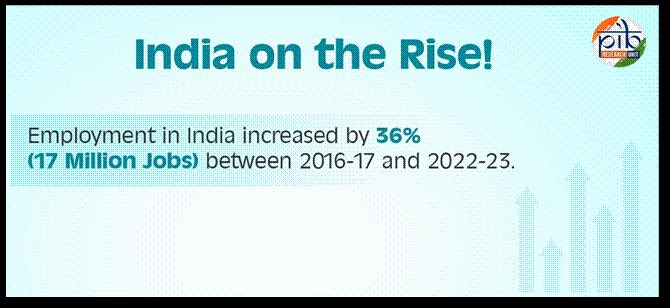
A Shift Away from “Jobless Growth
Recent data and economic analysis challenge the notion of “jobless growth” in India, a concept that suggests GDP growth occurs without corresponding increases in employment. A recent report from Observer Research Foundation titled ‘Busting the myth of jobless growth: Insights from data, theory, and logic’ explains the employment trends in India over the years to present a different story.


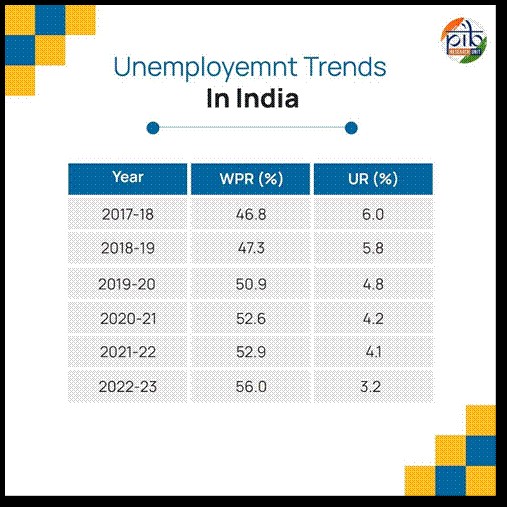
Key Highlights of the Report
- India’s Employment Growth: Contrary to the claims of “jobless growth,” data shows that employment in India increased by 36% (17 million jobs) between 2016-17 and 2022-23. During the same period, GDP grew at an average rate of over 6.5%.
- KLEMS Database Consistency: Employment data from the Reserve Bank of India’s KLEMS database, which relies on surveys like the Employment and Unemployment Survey (EUS) and Periodic Labour Force Survey (PLFS), indicates a steady rise in employment since the 1980s.
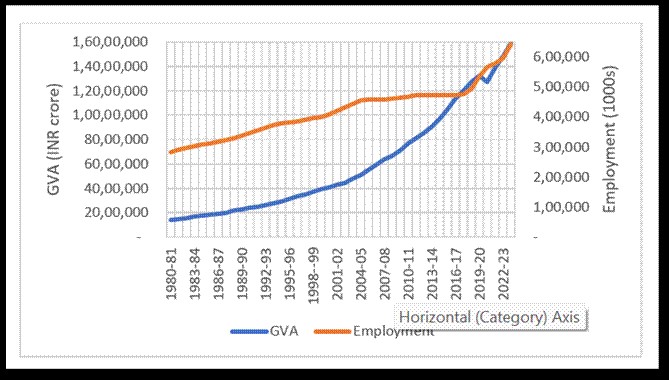
- Worker Population Ratio (WPR): The PLFS data from 2017 to 2023 also suggests that Worker Population Ratio (WPR) has increased by 9 percentage points or almost 26 percent during this period. Therefore, the rhetoric of “joblessness” really does not hold water in terms of cross- comparison of databases.
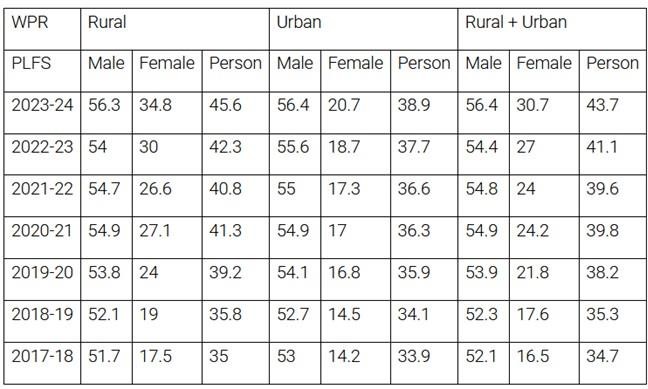
Worker Population Ratio ( In percentage)
- Consumption-Driven Growth: India’s growth has been driven by consumption, which is closely tied to employment. A rise in consumption implies that employment generation is occurring, as
consumption would decline if employment were predominantly in unpaid or low-wage jobs.

Real Monthly Per capita Consumption Expenditure and its growth rate
- Employment Elasticity: Employment elasticity is a rational measure for checking the causal relation between growth and employment generation in an economy. The report’s estimates, based on a linear econometric model, show that for the period 2017-23, there was a 1.11 percent increase in jobs for a percent increase in value added.
- Sectoral Observations: The labour-capital ratio in the economy as a whole is around 1.11 and that for the services sector is 1.17. Thus, the supply-side argument that services fail to generate jobs due to their low labour intensity is not corroborated by these observations—rather it is the other way around. Hence, from both the supply- and demand-side, India’s economic orientation is inconsistent with any form of joblessness.
In conclusion, India’s employment growth, linked to its consumption-driven economic model, disproves the joblessness myth!
Economic Survey of India
The latest Economic Survey of India highlights significant improvements in employment and skill development. The survey provides data that aligns with the findings of the report that employment is on the rise in India. Key trends of Economic Survey include:
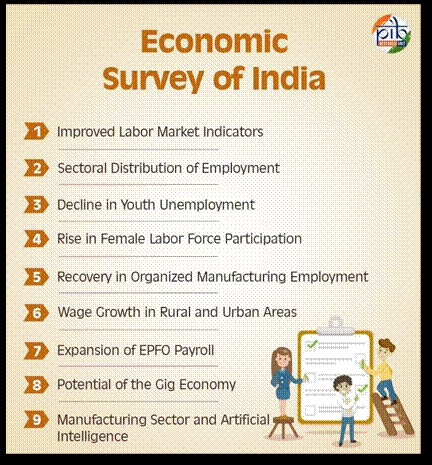
- Improved Labor Market: Indian labour market indicators have improved significantly with the unemployment rate declining to 3.2 per cent in 2022-23.
- Sectoral Employment: Agriculture remains dominant, employing over 45% of the workforce, though there is a gradual shift toward manufacturing and services.
- Youth Employment: According to PLFS, youth (age 15-29 years) unemployment rate has declined from 17.8 per cent in 2017-18 to 10 per cent in 2022-2
- Female Workforce Participation: The female labor participation rate has steadily increased due to supportive policies.
- Manufacturing Recovery: Factories employing over 100 workers experienced 11.8% growth between FY18 and FY22, indicating that larger industrial units are creating more jobs than smaller ones.
- Wage Growth: During FY15-FY22, the wages per worker in rural areas grew at 6.9 per cent CAGR visà-vis a corresponding 6.1 per cent CAGR in urban areas. This growth reflects the rising demand for labor in rural industries such as construction and manufacturing, as well as public
employment programs like Mahatma Gandhi National Rural Employment Guarantee Act (MGNREGA).
- EPFO Payroll Growth: The yearly net payroll additions to the EPFO have more than doubled from
61.1 lakh in FY19 to 131.5 lakh in FY24, driven by new job creation and greater formalization of employment.
- Gig Economy: India’s gig economy is expanding rapidly, with the workforce in this sector expected to grow to 2.35 crore by 2029-30.
- Manufacturing and AI: The manufacturing sector remains shielded from automation, offering continued job growth opportunities.
Understanding India’s Economic Profile
India’s economic performance in FY 2023-24 reflects robust growth. Real GDP has been estimated to grow by 8.2% in FY 2023-24 as compared to the growth rate of 7.0% in FY 2022-23. Nominal GDP has witnessed a growth rate of 9.6% in FY 2023-24 over the growth rate of 14.2% in FY 2022-23. Real Gross Value Added (GVA) has grown by 7.2% in 2023-24 over 6.7% in 2022-23. This GVA growth has been mainly due to significant growth of 9.9% in Manufacturing sector in 2023-24 over
-2.2% in 2022-23 and growth of 7.1% in 2023-24 over 1.9% in 2022-23 for Mining & Quarrying sector. Real GVA and Real GDP have been estimated to grow by 6.3% and 7.8% respectively in Q4 of FY 2023-24. Real GDP is estimated to attain a level of ₹173.82 lakh crore in the year 2023-24, against the First Revised Estimates (FRE) of GDP for the year 2022-23 of ₹160.71 lakh crore.
These numbers paint a strong and progressive picture of India!
Conclusion
India’s employment landscape has improved significantly, with government policies, skilling programs, and economic growth contributing to job creation. As India leverages its demographic dividend, further investments in education, health, and skill development will be critical for sustaining this positive employment trajectory.
 Matribhumi Samachar English
Matribhumi Samachar English


